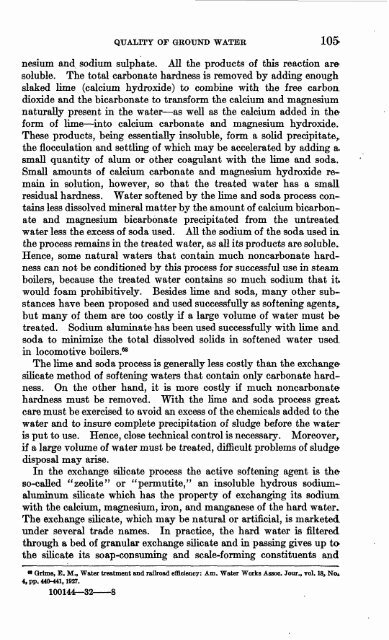GROUND WATER IN NORTH-CENTRAL TENNESSEE
GROUND WATER IN NORTH-CENTRAL TENNESSEE
GROUND WATER IN NORTH-CENTRAL TENNESSEE
Create successful ePaper yourself
Turn your PDF publications into a flip-book with our unique Google optimized e-Paper software.
QUALITY OF <strong>GROUND</strong> <strong>WATER</strong> 105<br />
nesium and sodium sulphate. All the products of this reaction are-<br />
soluble. The total carbonate hardness is removed by adding enough<br />
slaked lime (calcium hydroxide) to combine with the free carbon<br />
dioxide and the bicarbonate to transform the calcium and magnesium<br />
naturally present in the water as well as the calcium added in the-<br />
form of lime into calcium carbonate and magnesium hydroxide.<br />
These products, being essentially insoluble, form a solid precipitate,,<br />
the flocculation and settling of which may be accelerated by adding a,<br />
small quantity of alum or other coagulant with the lime and soda.<br />
Small amounts of calcium carbonate and magnesium hydroxide re<br />
main in solution, however, so that the treated water has a small<br />
residual hardness. Water softened by the lime and soda process con<br />
tains less dissolved mineral matter by the amount of calcium bicarbon<br />
ate and magnesium bicarbonate precipitated from the untreated<br />
water less the excess of soda used. All the sodium of the soda used in<br />
the process remains in the treated water, as all its products are soluble..<br />
Hence, some natural waters that contain much noncarbonate hard<br />
ness can not be conditioned by this process for successful use in steam<br />
boilers, because the treated water contains so much sodium that it.<br />
would foam prohibitively. Besides lime and soda, many other sub<br />
stances have been proposed and used successfully as softening agents,,<br />
but many of them are too costly if a large volume of water must be-<br />
treated. Sodium aluminate has been used successfully with lime and.<br />
soda to minimize the total dissolved solids in softened water used,<br />
in locomotive boilers.68<br />
The lime and soda process is generally less costly than the exchange-<br />
silicate method of softening waters that contain only carbonate hard<br />
ness. On the other hand, it is more costly if much noncarbonate-<br />
hardness must be removed. With the lime and soda process great<br />
care must be exercised to avoid an excess of the chemicals added to the<br />
water and to insure complete precipitation of sludge before the water<br />
is put to use. Hence, close technical control is necessary. Moreover,<br />
if a large volume of water must be treated, difficult problems of sludge-<br />
disposal may arise.<br />
In the exchange silicate process the active softening agent is the-<br />
so-called "zeolite" or "permutite," an insoluble hydrous sodium-<br />
aluminum silicate which has the property of exchanging its sodium<br />
with the calcium, magnesium, iron, and manganese of the hard water.<br />
The exchange silicate, which may be natural or artificial, is marketed<br />
under several trade names. In practice, the hard water is filtered<br />
through a bed of granular exchange silicate and in passing gives up to<br />
the silicate its soap-consuming and scale-forming constituents and<br />
** Qrime, E. M., Water treatment and railroad efficiency: Am. Water Works Assoc. Jour., vol. 18, No*.<br />
4, pp. 440-441,1927.<br />
100144r 32 8

















